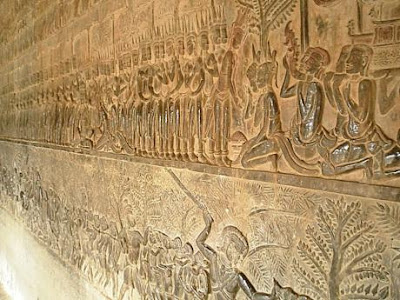America’s hegemonic tendencies sometimes disallow us to understand diversity in cultural events and customs. We perceive our norms and values as “right” and any practice outside of America as “inferior” or “wrong.” The important thing to remember though, and something I am learning now, is that certain customs, like art and drama, are culturally diverse. To define is to limit. By defining what theatre is to Americans is to limit our understanding, perceptions, and appreciation of other culture’s representation of theatre
In the film we watched last Monday, an extremely unique perception of theatre is shown. In Indonesia, theatre takes a much different form than what is typically represented in the West. The performance is not only used for entertainment value, but as an actual ceremonial practice and ritual for the Gods. It is less of a “play,” and more of a story being told through their oral tradition. Hence, the actors are not merely acting, but participating. I find this extremely fascinating and much more rewarding than what is typically done in the West. Through participation, the actors are able to undergo something for a personal purpose, something that is juxtaposed with the mere entertainment actors typically perform for in the America and the West. In performances I have been in, specifically Shakespeare’s The Taming of the Shrew, I know that I have gone to great lengths to merely entertain. There were a few moments throughout the play where I did truly get invested in the emotionality of what was occurring, but I was never able to lose the underlying need to preform and entertain. I would dramatize scenes that didn’t need to be solely for the purpose of comedic relief. It was never for intrinsic purposes. Even when watching plays I see this as well. That is the theatre I know and one that dominates the West. This is not to say that accomplished actors in the West do not undergo some sort of “change” or “transformation”, but it is for a much different purpose; one influenced by entertainment. In this Indonesian theatre, actors are taken over by a trance during the performance. This trance is thought to either be a spirit inside of you or your inner struggles personified within the community. They become so entranced that they are taken inside after the performance to get out of it. By allowing themselves to undergo such a state, it shows how committed they are to their craft. It is something more to them than just work; it has become their lives. Exemplified through the use of characters that represent dharma and adharma (the dragon Barong and the witch Calon Arong) and the necessary balance between them, they practice cultural customs and values within their performance. This type of theatre personifies the cultural values that are so intrinsically imbedded within each member of the community.
I find this direct correlation between culture and art fascinating and something that should be strived for worldwide. Whereas Americans go to the theatre for entertainment and maybe to find some sort of catharsis, Indonesians perform in order to satisfy something within themselves and to further the community. It isn’t solely an art form, but a cultural and spiritual practice. I think this idea brings so much more meaning and importance to theatre. It makes it personal. If this could be done in America or at least understood and appreciated, I think more people would take interest in theatre in all of its forms.












